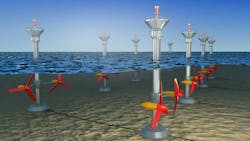Harnessing the Power of Tidal Energy (Download)
A major source of tidal energy comes from the natural rise and fall of the Earth’s oceans due to the gravitational interaction between the Sun, the Earth, and the Moon. As opposed to solar and wind power, tidal energy is far more predictable. Major disadvantages of tidal energy, though, are a scarcity of available ocean sources that have high flow velocity or high tidal ranges.
The good news is recent technological advances and knowledge in design (e.g., dynamic tidal power and tidal lagoons) and turbine technology (e.g., new axial turbines and cross flow turbines) show that the total availability of tidal power may be much higher than once thought. As a bonus, environmental and economic costs may now be able to be lowered to more competitive levels.
